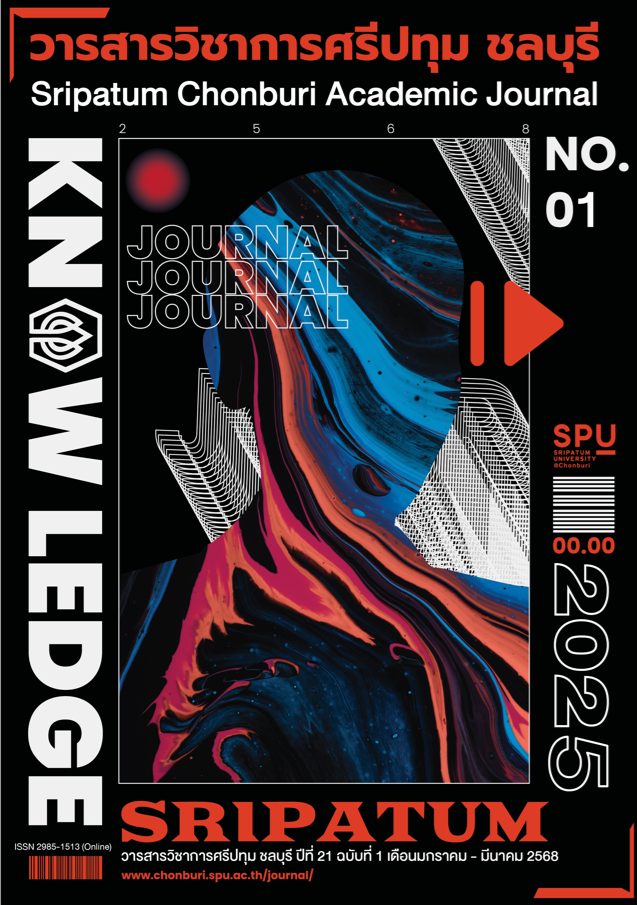MARKETING MIX FACTORS THAT AFFECT THE DECISION TO CHOOSE EYEBROWS TATTOO IN BANGKOK AND VICINITY
Keywords:
Beauty Enhancement, Eyebrow TattooingAbstract
This research aimed to investigate 1) marketing mix factors influencing the utilization of eyebrow tattooing services, 2) decision-making processes in using eyebrow tattooing services, 3) comparative analysis of decision-making based on personal data among consumers of eyebrow tattooing services, and 4) market factors influencing the decision-making process in utilizing eyebrow tattooing services. The samples, selected through accidental sampling, consisted of 400 individuals who utilized eyebrow tattooing services in Bangkok and its metropolitan area. A questionnaire was employed as the data collection tool. Statistical analyses included frequency, percentage, mean, standard deviation, hypothesis testing methods such as t tests (Independent Samples), F tests (One-Way ANOVA) for variance analysis, and Multiple Regression Analysis using the Enter method for variable selection.
The research findings revealed that marketing mix factors significantly influenced the decision to utilize eyebrow tattooing services at a statistically significant level. The consensus level on decision-making regarding the use of eyebrow tattooing services was notably high. Gender and age differences did not significantly affect the decision-making process, while variations in educational level, occupation, and average monthly income significantly influenced the decision-making process regarding eyebrow tattooing services. Marketing mix factors in terms of marketing promotion also significantly impacted the decision to use eyebrow tattooing services at a statistically significant level of .05.
References
บุญชม ศรีสะอาด. (2545). การวิจัยเบื้องต้น (พิมพ์ครั้งที่ 7). กรุงเทพฯ: สุวีรียาสาส์น.
ณิชชา ชัยปฏิวัติ. (2559). ปัจจัยที่มีอิทธิพลต่อการเลือกใช้บริการศัลยกรรมบนใบหน้าของผู้หญิงวัยผู้ใหญ่ตอนต้นในเขตกรุงเทพฯ. วิทยานิพนธ์วิทยาศาสตรมหาบัณฑิต สาขาวิชาวิทยาการชะลอวัยและฟื้นฟูสุขภาพ, คณะวิทยาศาสตร์ประยุกต์ มหาวิทยาลัยธุรกิจบัณฑิตย์.
ธัญชนก สุขแสง. (2556). ค่านิยมและอิทธิพลจากบุคคลที่ส่งผลต่อกระบวนการตัดสินใจศัลยกรรมความงาม.การค้นคว้าอิสระบริหารธุรกิจมหาบัณฑิต สาขาวิชาการตลาด, บัณฑิตวิทยาลัย มหาวิทยาลัยกรุงเทพ.
ธิดารัตน์ ภูมิชัยสิทธิ์. (2564). การตัดสินใจเลือกใช้บริการคลินิกเสริมความงามของผู้หญิงวัยทำงานในอำเภอเมืองสมุทรปราการ. การค้นคว้าอิสระบริหารธุรกิจมหาบัณฑิต สาขาวิชาการตลาด, คณะบริหารธุรกิจ มหาวิทยาลัยรามคำแหง.
ภัคจิรา ก้อนพร. (2562). ปัจจัยส่วนประสมการตลาดที่มีผลต่อลูกค้าในการทำศัลยกรรมความงามในเขตกรุงเทพมหานครและปริมณฑล. การค้นคว้าอิสระบริหารธุรกิจมหาบัณฑิต สาขาวิชาการตลาด, คณะบริหารธุรกิจ มหาวิทยาลัยรามคำแหง.
วิชย์ ณ พัทลุง. (2563). ความไม่สมบูรณ์แบบในความงาม. วิทยานิพนธ์ศิลปมหาบัณฑิต สาขาวิชาทัศนศิลป์, บัณฑิตวิทยาลัย มหาวิทยาลัยศิลปากร.
เอดิน่า. (2565). สักคิ้ว 3 มิติ สักคิ้วถาวร 2 มิติ แตกต่างกันอย่างไร (ออนไลน์). เข้าถึงได้จาก:
https://www.adenaa.com/101-what-is-the-difference-between-3d-eyebrow-tattoo-and-2d-permanent-eyebrow-tattoo/ [2565, 27 ตุลาคม].
Cochran, W. G. (1977). Sampling Techniques (3rd ed.). New York: John Wiley & Sons.
Cronbach, Lee. J. (1984). Essential of Psychology testing (4th ed.). New York: Harper & Row.
Kotler, P., & Keller, K. L. (2016). Marketing Management (14th ed.). Shanghai: Shanghai People’s.
Rovinelli, R. J., & Hambleton, R. K. (1977). On the use of content specialists in the assessment of criterion-referenced test item validity. Tijdschrift voor Onderwijsresearch, 2(2), pp. 49–60.
Schiffman, L. G., Kanuk, L. L., & Kumar, S. R. (2010). Consumer Behavior (10th ed.). New Delhi: Pearson Education.
Downloads
Published
Issue
Section
License
Copyright (c) 2024 Sripatum University Chonburi Campus

This work is licensed under a Creative Commons Attribution-NonCommercial-NoDerivatives 4.0 International License.
บทความทุกบทความเป็นลิขสิทธิ์ของวารสารวิชาการศรีปทุม ชลบุรี



